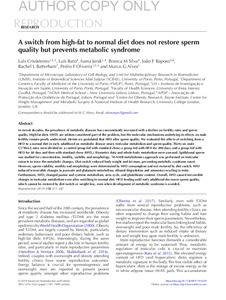A switch from high-fat to normal diet does not restore sperm quality but prevents metabolic syndrome
Jarak I; Raposo JF; Batterham RL; Crisóstomo L; Silva BM; Oliveira PF; Alves MG; Rato L
A switch from high-fat to normal diet does not restore sperm quality but prevents metabolic syndrome
Jarak I
Raposo JF
Batterham RL
Crisóstomo L
Silva BM
Oliveira PF
Alves MG
Rato L
Lataukset:
BIOSCIENTIFICA LTD
Julkaisun pysyvä osoite on:
https://urn.fi/URN:NBN:fi-fe2022091258649
https://urn.fi/URN:NBN:fi-fe2022091258649
Tiivistelmä
In recent decades, the prevalence of metabolic diseases has concomitantly increased with a decline on fertility rates and sperm quality. High-fat diets (HFD) are seldom considered part of the problem, but the molecular mechanisms underlying its effects on male fertility remain poorly understood. Herein we postulated that HFD alter sperm quality. We evaluated the effects of switching from a HFD to a normal diet in early adulthood on metabolic disease onset, testicular metabolism and sperm quality. Thirty-six male C57BL6/J mice were divided in: a control group fed with standard chow; a group fed with HFD for 200 days; and a group fed with HFD for 60 days and then with standard chow (HFDt). Biometric data and whole-body metabolism were assessed. Epididymal sperm was studied for concentration, motility, viability and morphology. H-1-NMR metabolomics approach was performed on testicular extracts to trace the metabolic changes. Diet switch reduced body weight and fat mass, preventing metabolic syndrome onset. However, sperm viability, motility and morphology were deteriorated by HFD consumption and not restored by diet switch. HFD induced irreversible changes in pyruvate and glutamate metabolism, ethanol degradation and ammonia recycling in testis. Furthermore, HFDt changed purine and cysteine metabolism, urea cycle, and glutathione content. Overall, HFD caused irreversible changes in testicular metabolism even after switching to normal diet. HFD feeding until early adulthood decreases sperm quality, which cannot be restored by diet switch or weight loss, even when development of metabolic syndrome is avoided.
Kokoelmat
- Rinnakkaistallenteet [19207]
